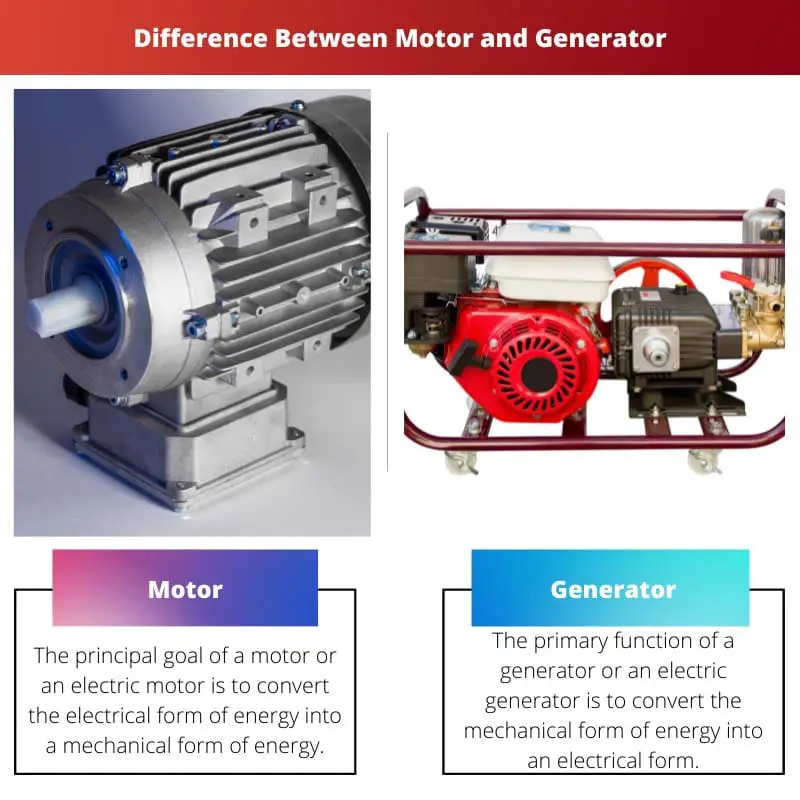The energy conversion technology, the link with electricity, the concept employed, the rule by which direction can be decided, the primary accessories used, the way shafts are joined, and instances of both types of mechanical devices are the differences between motor and generator.
Key Takeaways
- Motors convert electrical energy into mechanical energy for various applications.
- Generators produce electrical energy from mechanical energy, such as internal combustion engines.
- Motors use an external power source, while generators supply power to other devices.
Motor vs Generator
A motor is a device that converts electrical energy into mechanical energy. It works by using an electric current to create a magnetic field, which in turn generates a rotational force that can be used to power a machine or device. A generator converts mechanical energy into electrical energy. It works by using a mechanical force to rotate a coil of wire within a magnetic field, which induces an electrical current in the wire.

A motor is specifically designed for the production of the mechanical form of energy from the energy which is in electrical form.
A generator, known as an electric generator, is a machine that converts the mechanical form of energy into electrical. A generator or an electric generator works on the concept of electromagnetic induction (EMI).
Comparison Table
| Parameters of Comparison | Motor | Generator |
|---|---|---|
| Energy conversion | Electrical – Mechanical | Mechanical – Electrical |
| Linkage with electricity | Run via the electricity. | Produces electricity. |
| Concept | In a magnetic field, Charge carrying conductor rotates. | Works according to electromagnetic induction. |
| Direction | Fleming’s left-hand rule is used. | Fleming’s right-hand rule is used. |
| Main Accessories used | Commutators and split rings. | Slip rings. |
| Shaft attached | Driven between the field and the armature, by the strong magnetic force. | Driven by the strong mechanical force. |
| Example | Electric bikes and electric cars. | Electricity supplied to households. |
What is Motor?
The principal goal of a motor or an electric motor is to convert the electrical form of energy into a mechanical form of energy. The motor runs and is powered via the use of electricity.
The motor runs on the concept that when any conductor carrying charge is kept in a magnetic field, the conductor rotates as it is subjected to a significant amount of force.
The direction in which the force is slanted in an electric motor can be determined using Fleming’s left-hand rule notion. Commutators and split rings are two accessories that are utilised in motors or electric motors.

What is Generator?
The primary function of a generator or an electric generator is to convert the mechanical form of energy into an electrical form.
The direction in which the current is induced in a generator can be determined using Fleming’s right-hand rule. Slip rings, which are copper rings that are placed co-axially, are one of the many accessories used in an electric generator.
The energy produced at power plants in the form of electrical energy, more known as electricity, is an example of an electric generator.

Main Differences Between Motor and Generator
- The shaft that is attached to the electric motor is strongly driven between the field and the armature by the strong magnetic force.
- The example of electric motors can be well cited in the case of electric bikes and electric cars. On the other hand, the example of an electric generator is the energy which is produced at the power stations in the form of electrical energy or commonly known as electricity.

- https://ieeexplore.ieee.org/abstract/document/491498/
- https://ieeexplore.ieee.org/abstract/document/400761/

The references in the article add scholarly weight to the content, making it a valuable resource for understanding the key differences between motors and generators.
The incorporation of academic references further elevates the credibility of the information presented.
The detailed explanation and comparison table make it easy to comprehend the complex concepts of energy conversion in motors and generators.
The use of real-world examples to illustrate the concepts adds practical relevance to the article.
I find the comparison table particularly helpful. It simplifies the differences effectively.
The article effectively highlights the core differences between motors and generators, providing detailed insights into their functions and operations.
This informative article covers the technical aspects of motor and generator technology, making it a valuable read.
The article’s focus on the fundamental aspects of motors and generators offers a solid educational resource.
The distinction between motors and generators is well-articulated. This provides a great foundation for anyone interested in understanding the subject.
It’s a well-researched and comprehensive article that covers all essential aspects of motors and generators.
The explanation of the working principles of both devices is very informative.
This article provides a well-structured comparison of motors and generators, backed by scholarly references and real-world examples for comprehensive understanding.
The detailed analysis of both electrical and mechanical aspects in the comparison makes this article a valuable educational tool.
The article effectively breaks down the complex concepts related to motors and generators, providing a structured comparison of the two devices.
The article’s focus on the specific mechanisms of motors and generators facilitates a deeper understanding of their functions.
The detailed explanation of electromagnetic principles in motors and generators enhances the educational value of this article.
This well-researched article delivers a comprehensive comparison of motor and generator technologies, offering valuable insights into their energy conversion processes.
The precision in detailing the differences between motors and generators is commendable, providing a strong educational foundation for readers.
The article effectively captures the technical nuances of both motors and generators, providing an intellectually stimulating read.
This article provides a clear comparison between motors and generators, focusing on the key parameters of difference. It is well explained and provides a solid understanding of the topic.
I totally agree. It’s a comprehensive overview of the topic.
The references used in the article further strengthen the credibility of the content.
This article is a comprehensive comparison of motors and generators, providing an intellectual analysis of the technology behind each device.
The detailed explanation of the concepts involved in motor and generator functionality is highly informative.
The article effectively distinguishes between the functions and operations of motors and generators, providing a clear and informative narrative on the subject.
The detailed breakdown of complex concepts makes it a valuable resource for students and enthusiasts of electrical engineering.